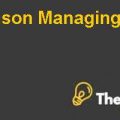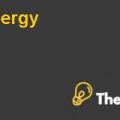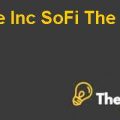Arauco (A): Forward Integration or Horizontal Expansion? Case Study Solution
Building the Proposed Nueva Aldea (Chile) Chemical Pulp Plant
Referring to the data provided in the case, the weighted average cost of capital is calculated by using a 4 percent risk free rate of return, 11 percent market rate of return and 17 percent tax rate. Additionally, the asset or unlevered beta is not converted into the project / levered or equity beta because of the usage of cost of equity as the weighted average cost of capital, hence the cost of equity is calculated to be 10.30 percent.
Based on the production capacity of the new plant in relation to the total production of the company, all the variable costs are proportionate in a similar production ratio in order to calculate the cost of the new plant. The variable cost include: labor, chemical, and wood, which leads to the total cost of mill amounting to $284000000. Furthermore, the pulp mills would operate 80%, 90% and 95% in the first, second and third year of operation.In addition to this, 1 million tonsare converted into the metric ton of 907184.74. Also, it is estimated that the new plant would most likely add 700000 million ton capacity, which equals to 635029.318 metric tons. The new plant would lead to anincreased capacity of production, leading to 2.3 million metric tons.
In the first year of the operation, the net present value of the mill would be $3092232493, whereas, in the second and third year of operation, the net present value of the mill would be $3092232428 and 3092232396respectively. A positive net present value of the project demonstrates that the present value of the revenues exceeds the present value of cost at the discounted rate of return. The net present value of the project is greater than zero or positive, which shows that building the chemical pulp plant would be more beneficial for the company, and project seems viable, profitable and feasible. The calculation can be seen in the Appendix.
Vertical Corporate Scope Strategy of Arauco
The cost and benefits of retaining its backward integration strategy by owning its own forests in addition to pulp production facilities, are as follows:
Pros
- The company could easily continue with its existing business model and strategy, and capitalize on its core competencies.
- The company could continue its production with the low cost operations of the business.
- The company would help to reduce the unemployment rate to about 8.5%.
- The company could leverage in terms of expanding & increasing the capacity.
Cons
- The company would notbe able to exploit and capture other market opportunities if it would continue its dependence on the creation of pulp as a source of the revenue generation.
The company is suggested to maintain its core competencies and retain its backward integration strategy by owning its own forests in addition to pulp production facilities because of the reason that the company has been operating in a similar industry for anumber of years. Also, it has significantly built a strong market presence and reputation as it was the main player in the market. In addition, most of the revenues generated by the company to the tune of 50 percent are derived from pulp sales. Furthermore, the company holds alargest share of the market for the unbleached soft pulp, which accounts for 15.8 percent of the market share of the world.
In the fiscal year 2003, the company had generated pulp sales accounting to 48.7 percent of the total sales of the company. The export strategy was also established by thecompany for its product, which in turn helpedit to thrive even in the midst of the adverse economic conditions as its export market served as a rescue for the local conditions of turbulent marketing. With these facts, the company is recommended to pursue a similar line of business as it has immensely built the brand image, which is highly known as both locally and internationally, helping it to curve a larger share of the market.
Arauco Forward Integrate into the Paper Business
Before deciding whether Arauco forward integration into the paper business, it is important to assess and evaluate the cost and benefit of the decision. The pros and cons of forwardintegration into the paper business are as follows:
Pros
- It would lead to a significant increase in the earnings of the company & some reduction in the cost as all the functions in the process of paper making would be kept within the organization.
- The paper industry is highly profitable and lucrative, providing an opportunity for the company to earn higher margins. Additionally, as the demand for paper is increasing with the passage of time in accordance with the growth of the economy, the company tends to generate higher profit margins.
- The diversification of the revenue streams would allow the company to reduce the risk to a greater extent.
- The company would be in a good position to reap the benefits of the economies of scale, which it enjoys currently, thus making it possible for the company to reduce the production cost and generate high returns
- The company would be able to improve its operational efficiencies and beat the market competition.
Cons
- The cost of forward integration into the paper industry would be higher, hence leading to little return with added risk.
- The cost would be incurred with the creation of the new departments.
- It would require the company to work outside and beyond its core competencies.
- The company would need research and development & large capital investment would be required in the equipment and property.
- The company has limited knowledge and experience & has no base in the market share for the paper production
- In order to generate the desirable profit returns, the company needs to establish an effective channel of distribution for both paper and pulp products, and would haveto buy the conversion facility, which would make it capable enough to meet the increasing demand of the paper.
The company is recommended to take advantage ofthe growing paper industry througha merger with CMPC – the main competitor of Arauco in Chile owns 424000 hectors of eucalyptus and pine forest in Chile and Argentina. Most of the revenues are generated from paper products within Latin America. The merger with CMPC would allow the company to strengthen itsposition in the pulp and paper market, and would help it to access additional earnings as the demand for paper increase. Additionally, the company could take advantage of the knowledge, expertise and experience of CPMC in the distribution, manufacturing and conversion of paper. Combining the existing infrastructure of CPMC for the pulp production with the raw material as well as pulp production technologies of Arauco, whichwould most likely place the company at the top for pulp and paper production............................
This is just a sample partical work. Please place the order on the website to get your own originally done case solution.












